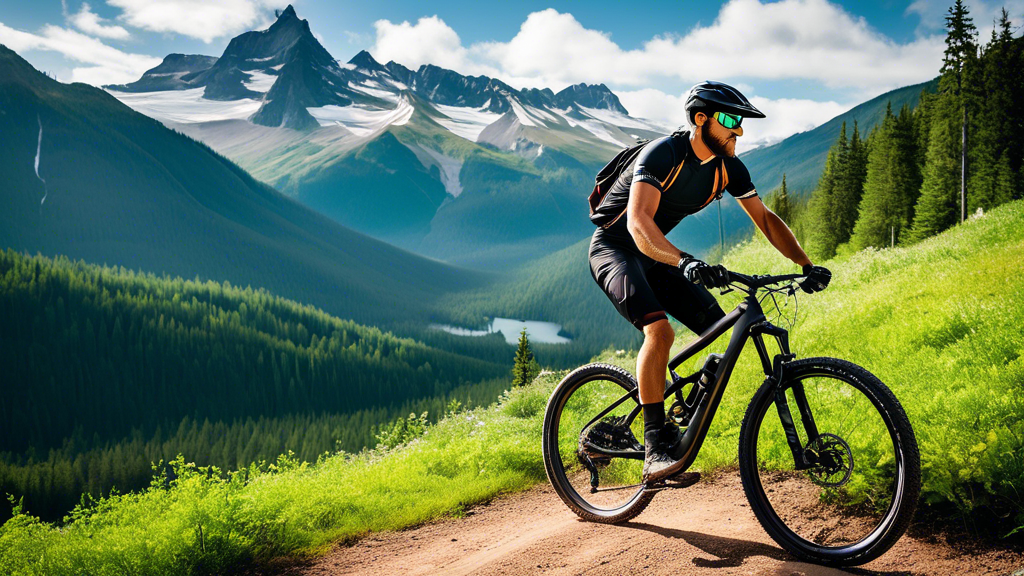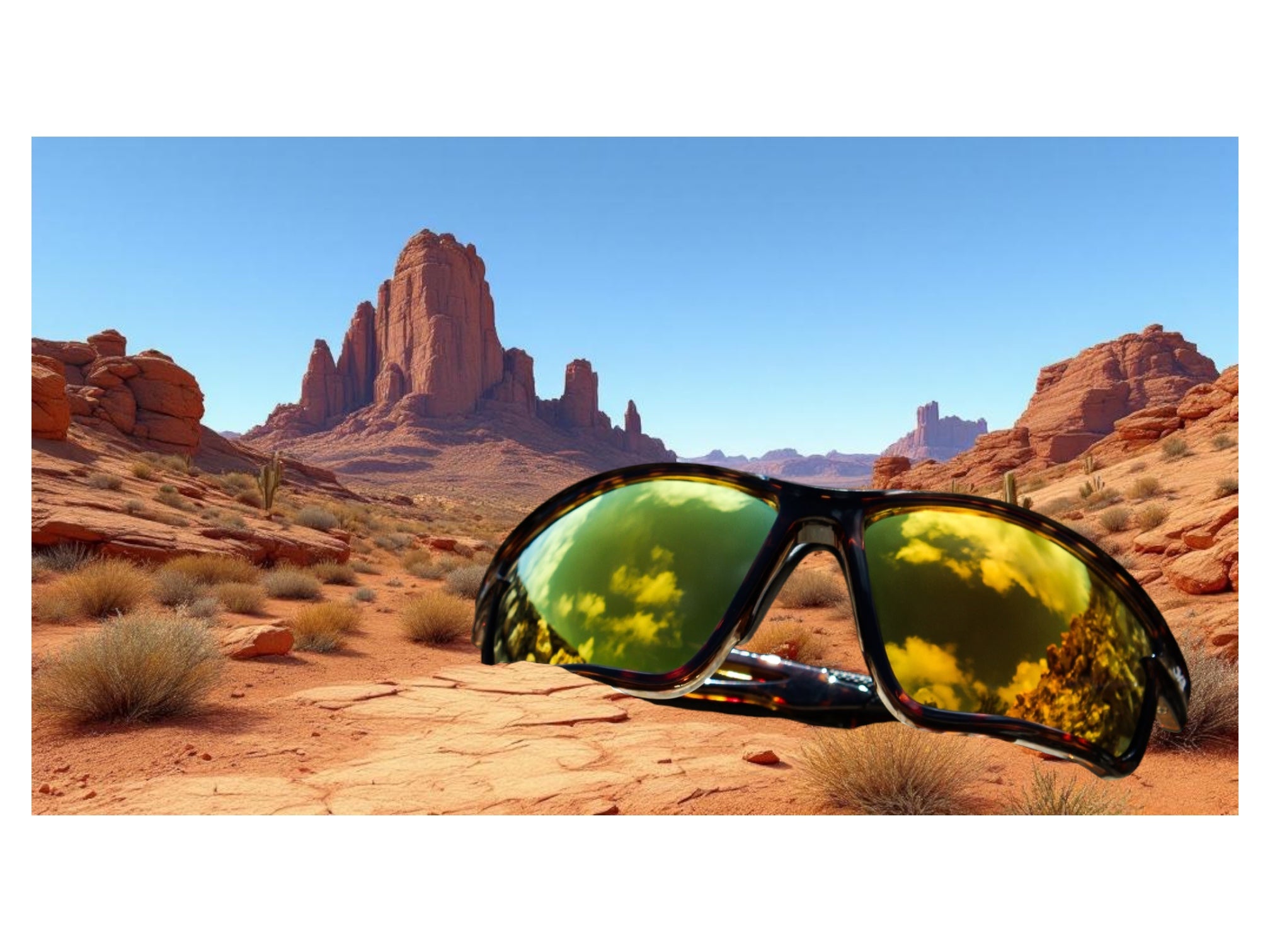Introduction: The Essential Role of High-Performance Sunglasses in Mountain Biking
|
|
Mountain biking is an exhilarating outdoor activity that combines the thrill of navigating rugged trails with the endurance of pedaling through unpredictable terrains. Among the gear essential for this demanding sport, high-performance sunglasses stand out as a critical component. They are not merely an accessory; they are an indispensable tool for the rider's safety, comfort, and overall performance.
The dynamic environment of mountain biking presents unique challenges that underscore the need for the right eyewear. Riders often encounter intense sunlight, shadows cast by trees, and rapidly changing light conditions, especially when transitioning between open trails and dense forest areas. Glare, UV radiation, and debris like dust, dirt, and bugs pose additional risks to vision clarity. High-performance sunglasses are designed to mitigate these challenges, offering protection and enhancing optical clarity.
Lens quality is pivotal in mountain biking sunglasses. Advanced lens technologies provide features such as 100% UV protection, impact resistance, and polarization to reduce glare. Photochromic lenses, which adjust to varying light conditions, are particularly advantageous for bikers tackling diverse landscapes. A precise fit and lightweight frame further ensure that the sunglasses stay secure and comfortable during long rides.
Safety is a non-negotiable priority in mountain biking, and sunglasses play a key role in shielding the rider’s eyes from potential hazards. Climbing rocky ascents or descending at high speeds often stirs up debris, and wearing durable polycarbonate lenses with a scratch-resistant coating can help reduce the risk of eye injuries.
The right sunglasses not only enhance safety but also optimize vision for better performance. By improving contrast and depth perception, these specialized lenses allow riders to accurately assess the trail ahead, whether navigating tight turns or choosing the optimal line through technical sections.
Key Features to Look for in Mountain Biking Sunglasses
When selecting the right mountain biking sunglasses, certain features are essential for enhancing performance, comfort, and safety. Riders should consider these critical aspects to ensure their sunglasses meet the demands of rough terrain and varying conditions.
1. Lens Material and Durability
High-quality lens materials, such as polycarbonate, are lightweight, impact-resistant, and ideal for mountain biking. These materials protect the eyes from debris while maintaining a clear view of the trail. Scratch-resistant coatings prolong lens life, especially when riding in dusty or abrasive environments.
2. UV Protection
Effective UV protection is essential for maintaining long-term eye health. Sunglasses should provide 100% protection against UVA, UVB, and UVC rays to shield the eyes from harmful ultraviolet radiation encountered in outdoor environments.
3. Lens Technology
Photochromic lenses automatically adjust to changing light conditions, making them suitable for shaded forest trails and open sunlit paths. Polarized lenses reduce glare, helping riders maintain clear vision during high sun exposure or reflective conditions. Anti-fog coatings are also critical for preventing condensation in humid or cold weather.
4. Coverage and Fit
Wraparound frames offer excellent protection by blocking wind, dust, and peripheral sunlight. A secure and comfortable fit is essential to keep the sunglasses in place over bumpy terrain. Adjustable nose pads and temple grips enhance stability and provide a personalized feel.
5. Ventilation System
Proper ventilation channels minimize fogging and maintain airflow without compromising protection. This feature is especially critical during intense rides, where sweat and temperature changes can obscure vision.
6. Lightweight and Durable Frame
Frames constructed from materials like TR-90 or nylon composites ensure toughness while remaining lightweight. These frames endure the rigors of mountain biking and enhance overall comfort for extended use.
7. Compatibility with Helmets and Goggles
Sunglasses should integrate seamlessly with a helmet to avoid pressure points and deliver a snug fit. Riders who use goggles may look for interchangeable designs that provide flexibility across different riding conditions.
Top Material Choices for Durable and Lightweight Frames
When selecting mountain biking sunglasses, the choice of frame material plays a crucial role in durability, comfort, and overall performance. Each material offers unique benefits, balancing resilience and lightweight characteristics to withstand the challenges of rugged outdoor use.
Key Materials for Frames:
- TR-90: This nylon-based thermoplastic is widely used in high-performance eyewear due to its exceptional flexibility, impact resistance, and ability to withstand extreme environmental conditions. Grilamid frames are both lightweight and durable, making them an ideal choice for mountain bikers tackling unpredictable terrains.
- Polycarbonate: Known for its robustness, polycarbonate delivers enhanced shatter resistance compared to other plastics. It can endure significant wear and tear, ensuring longevity. Although marginally heavier than some alternatives, it remains popular due to its reliability under demanding conditions.
- Carbon Fiber: For riders needing strength without sacrificing weight, carbon fiber provides an excellent option. This material offers a high strength-to-weight ratio and resists warping under pressure, making it perfect for intensive biking sessions. However, it can lean toward the expensive side.
- Aluminum Alloy: Lightweight yet sturdy, aluminum alloy frames cater to bikers who value durability along with a sleek and polished appearance. While not as commonly used as some polymers, aluminum provides an excellent option for those seeking style and sturdiness.
- Memory Plastic: Frames made from memory plastic combine flexibility with resilience, easily bending under stress but returning to their original shape. This material is designed for bikers who anticipate frequent impacts or drops.
The right material choice ultimately depends on individual needs and riding conditions, with each option offering its own set of advantages suited to varied terrains and intensities.
Lens Technologies that Enhance Clarity and Obstacle Detection
Modern mountain biking sunglasses are equipped with innovative lens technologies designed to optimize clarity and enhance obstacle detection under varying trail conditions. These advancements play a critical role in ensuring safety and performance for riders navigating dynamic terrains.
One of the most notable features is photochromic lenses, which automatically adjust their tint based on ambient light. This adaptive technology helps riders transition seamlessly between dense forest trails and open, sunlit paths without needing to switch glasses. By reducing glare and boosting contrast, photochromic lenses enable cyclists to detect trail irregularities such as rocks, roots, and ditches with ease.
Polarized lenses are another popular choice for mountain biking, especially in conditions where sunlight reflects off water puddles or wet surfaces. They reduce horizontal glare while preserving depth perception, allowing riders to focus better on the trail ahead. For those cycling on roads en route to a trail, these lenses can also combat the intensity of reflective surfaces like asphalt on sunny days.
Mirror-coated lenses, often categorized by their colorful, reflective appearance, provide additional protection against intense sunlight. They reflect excess light while maintaining sharp visual clarity, particularly useful during bright summer rides. Complementing this are hydrophobic and oleophobic coatings that repel water, mud, and oils, ensuring the lens surface remains clear and clean even in demanding, off-road conditions.
Many high-performance sunglasses also feature proprietary contrast-enhancing technologies. Brands like Oakley and Smith integrate specialized filters that boost color differentiation and sharpen detail perception. These enhancements make it easier to identify terrain changes, spot trail markers, and avoid potential hazards.
For riders seeking versatility, interchangeable lens systems offer a valuable advantage. These allow bikers to swap lenses based on weather and lighting, ensuring optimal vision regardless of the environment. Such systems often come with easy-to-use mechanisms, making mid-ride adjustments hassle-free.
Advanced anti-fog technologies are critical for preventing condensation build-up during sweaty climbs or cold-weather rides. Coatings or ventilation systems integrated into the lenses ensure consistent visibility, even in challenging conditions. Along with UV protection, these technological features provide comprehensive eye safety by filtering out harmful rays while heightening performance on trails.
UV Protection: Safeguarding Your Eyes from Harsh Sunlight
When navigating rugged mountain trails, exposure to UV rays can be a significant concern. Mountain bikers spend extended periods outdoors, often under the intense glare of the sun, which can lead to serious eye damage if precautions are not taken. High-quality mountain biking sunglasses equipped with UV protection act as a reliable barrier against ultraviolet radiation, ensuring safe and comfortable rides in diverse environments.
Prolonged UV exposure is known to cause eye issues ranging from temporary discomfort to long-term conditions such as cataracts, macular degeneration, and retinal damage. Sunglasses designed for mountain biking often feature lenses that block 100% of UVA and UVB rays. This advanced protection minimizes the risk of sun-related eye injuries, enabling riders to maintain focus and vision clarity without the discomfort caused by glare or strain.
Performance-oriented sunglasses frequently feature wraparound designs that provide enhanced coverage, shielding not just the eyes but also the sensitive skin around them. Such designs are particularly effective in offering protection against peripheral sunlight, dirt, and debris, creating an all-encompassing safeguard for the rider during downhill descents or challenging uphill climbs.
Lens technology plays a pivotal role in UV protection. Many top brands utilize polarized or photochromic lenses that automatically adjust to changing light conditions. This feature allows riders to effortlessly transition between shaded forest paths and wide-open sunlit stretches without compromising visibility. Additionally, anti-reflective coatings reduce glare from reflective surfaces such as water or wet mud, amplifying comfort during long rides.
Selecting sunglasses with certified UV protection is essential for riders who prioritize safety and performance. Trusted manufacturers often include specific certifications or markings on their products, indicating the level of protection offered. Paying close attention to these details ensures riders invest in gear that not only boosts comfort but actively preserves their optical health for years to come.
How Anti-Fog Coating Improves Vision in Challenging Conditions
Anti-fog coating technology is designed to enhance visibility by preventing condensation buildup on lenses, particularly under demanding environmental conditions. For mountain bikers navigating varying terrains, the ability to maintain clear vision is essential. Factors such as temperature fluctuations, humidity, and physical exertion often lead to lens fogging, which can obscure the rider’s view and reduce reaction times. By incorporating anti-fog coating onto sunglasses, riders benefit from lenses that resist fog formation, enabling uninterrupted visual clarity.
Unlike traditional lenses, anti-fog-coated sunglasses are engineered with a hydrophilic layer that disperses moisture evenly. This mechanism eliminates the formation of micro-droplets that cause fogging, ensuring the lens surface remains transparent. Mountain bikers often face drastic changes in temperature, such as during early morning rides or ascending and descending varied elevations. Anti-fog coatings help the lens adapt seamlessly to these conditions, maintaining optimal performance in both cold and warm environments.
Advancements in anti-fog technology have also extended functionality by integrating durable and scratch-resistant materials. This ensures riders can rely on sunglasses for long-term use without degradation of the protective coating. Modern anti-fog solutions are compatible with diverse lens types, including polarization and photochromic lenses, providing enhanced options for bikers seeking optimal visual comfort in different lighting conditions.
Moreover, the application of anti-fog coatings is beneficial in scenarios involving sudden exertion, where perspiration and body heat exacerbate fogging. Whether maneuvering through muddy trails or misty forests, riders equipped with anti-fog sunglasses are empowered with consistent clarity. Enhanced visibility translates directly to better safety and improved performance, particularly in unpredictable environments common to off-road cycling.
In addition to clearing fog, anti-fog coatings contribute to overall lens hygiene by reducing water streaks and smudges, which can accumulate during intense activity. Choosing sunglasses with high-performance anti-fog technology ensures mountain bikers are prepared to tackle challenges head-on while prioritizing their visual experience.
The Importance of Comfortable Fit for Long Riding Sessions
A comfortable fit in mountain biking sunglasses is crucial for riders who spend extended hours on trails. Long riding sessions require gear that enhances performance while ensuring the rider stays focused without distractions. Sunglasses that are ill-fitted can lead to constant adjustments, discomfort, or even headaches, detracting from the biking experience. Therefore, the design and fit of mountain biking sunglasses should cater to both stability and ease of wear.
Frames that sit securely on the face without causing pressure points are essential. Lightweight materials, such as polycarbonate or nylon, are often used to prevent the sunglasses from feeling heavy on the bridge of the nose or temples. Additionally, adjustable features like nose pads and temple grips allow for customization, resulting in a snug fit that conforms to various head shapes and sizes. Grippy rubberized components also play a significant role in keeping the glasses in place during rigorous movement, even when sweat is present.
Ventilation within the frame design is another factor that promotes comfort during long rides. Proper airflow prevents fogging on the lenses and allows heat to dissipate, ensuring the rider maintains a clear and consistent field of vision. Many high-quality sunglasses incorporate vented frames specifically for this purpose.
Moreover, sunglasses with an ergonomic design take into account the natural contours of a rider’s face. Some models are designed to accommodate the use of helmets seamlessly, avoiding interference at contact points. Choosing sunglasses that integrate well with other biking gear enhances overall comfort and convenience.
The long-term wearability of mountain biking sunglasses directly affects the rider's endurance and focus, making comfort a non-negotiable feature when selecting the right pair.
Interchangeable Lenses vs. Photochromic Options: Which One to Choose?
Selecting between interchangeable lenses and photochromic options for mountain biking sunglasses depends on riding conditions, personal preferences, and individual needs. Both systems offer unique advantages tailored to specific scenarios.
Interchangeable lens systems provide versatility, allowing riders to swap lenses based on environmental conditions. Cyclists can use darker lenses for sunny days, clear options for low-light settings, or mirrored finishes to reduce glare. This flexibility is beneficial for riders who frequently transition between different terrains and light exposures. Advanced systems with magnetic or clip-in mechanisms make lens changes effortless even during mid-ride breaks. However, managing multiple lenses may require additional storage, care, and organization.
Photochromic lenses, on the other hand, eliminate the need for manual adjustments by automatically adapting to lighting changes. These lenses darken in bright light and lighten in shaded or cloudy conditions, ensuring seamless visual clarity. This feature makes photochromic options ideal for riders moving through forested trails, where light intensity varies frequently. Unlike interchangeable lenses, they eliminate the risk of losing or damaging extra lens sets. However, photochromic lenses may transition slower in extreme lighting shifts and sometimes cannot achieve the same level of darkness as a dedicated tinted lens.
When durability and maintenance are considered, both options come with their challenges. Interchangeable lenses can be prone to scratches during frequent swaps, while photochromic coatings may wear over time, potentially affecting responsiveness. Riders prioritizing convenience often gravitate toward photochromic lenses, whereas those seeking customizability may favor interchangeable systems.
Ultimately, the choice is highly context-dependent. Factors such as riding habits, average trail environments, and budget constraints should guide decisions to ensure optimal performance and comfort for every adventure.
Top 10 Mountain Biking Sunglasses for 2023: Our Expert Picks
Finding the right mountain biking sunglasses is essential for tackling changing light conditions, protecting your eyes from debris, and ensuring maximum comfort on rugged trails. The following expert-recommended models have been chosen for their durability, optical clarity, and fit, making them ideal for mountain biking enthusiasts.
1. Oakley Sutro S PRIZM Trail
Designed with a bold frame and PRIZM lens technology, these sunglasses excel in enhancing color contrast and depth perception in trail environments. They offer a snug fit and optimal coverage.
2. Smith Wildcat
With the oversized lens design, the Wildcat provides superior protection and standout clarity. Its ChromaPop lenses filter out glare while improving color contrast, and the adjustable nose pads ensure a custom fit.
3. 100% S3 Sunglasses
The S3 blends performance with style. Offering excellent UV protection, impact resistance, and interchangeable lenses, it's a go-to choice for riders navigating variable light conditions.
4. Rudy Project Defender
Known for its lightweight yet durable construction, the Defender combines cutting-edge optics with wide lenses, improving peripheral vision and shielding eyes from dust.
5. Julbo Fury
Designed for high-speed trail rides, the Fury boasts photochromic lenses that adapt to lighting changes. Its airflow vents prevent fogging and maintain comfort during challenging climbs.
6. Tifosi Sledge Lite
Featuring a budget-friendly price, the Sledge Lite offers a full-frame lens with excellent UV protection. Riders appreciate its lightweight build and shatterproof features for rough terrains.
7. POC Devour
This model acts as a shield, blending sunglasses and goggles. The oversized design and Ri-Pel lens treatment make it ideal for dusty conditions and muddy trails.
8. Rapha Pro Team Full Frame
The Pro Team Full Frame delivers excellent optics with a lightweight fit. Its anti-fog lens technology and adjustable arms ensure durability on uphill and downhill rides.
9. Troy Lee Designs Cross Country Sunglasses
Engineered specifically for trail challenges, these sunglasses feature scratch-resistant lenses and hydrophilic rubber ear socks that maintain grip even with sweat.
10. JBX - NIXIE
JBX - NIXIE sunglasses stand out with their customizable fit and stylish frame design. The wide-angle lens improves visibility, making it suitable for technical trails and fast descents.
Each of these options has been crafted with the demands of mountain biking in mind, offering unparalleled performance and reliability on every trail. Their varying price points and features ensure there’s a model to suit different preferences.
Breakdown of Price vs. Performance for Each Sunglass Option
When evaluating mountain biking sunglasses, the balance between price and performance is crucial for riders seeking clear vision and comfort. The options listed below are assessed based on their value, technical features, durability, and suitability for different conditions.
Premium Options
- Oakley Jawbreaker
- Price: High
- Performance: Exceptional optical clarity and wide field of view due to the proprietary Prizm lens technology. Offers unmatched durability for rough trails with lightweight O-Matter frame construction.
- Smith Attack Max
- Price: High
- Performance: Advanced ChromaPop lenses deliver enhanced color contrast and detail. The interchangeable lenses allow adaptability for varying light conditions. High comfort is ensured with adjustable nose pads.
Mid-Range Options
- Tifosi Davos
- Price: Moderate
- Performance: Polycarbonate lenses provide solid UV protection and shatter resistance. Multi-lens options are ideal for transitioning between bright and shaded environments.
- Rudy Project Tralyx
- Price: Moderate
- Performance: Lightweight construction and impact-resistant lenses make these reliable for long mountain rides. Ventilation channels prevent fogging during intense activity.
- 100% S3 Sunglasses
- Price: Moderate
- Performance: Striking a balance between style and functionality, these sunglasses feature HiPER lenses for sharp vision and enhanced terrain visibility. The sturdy frame ensures longevity.
Budget-Friendly Options
- Goodr OG Sunglasses
- Price: Low
- Performance: Despite their low cost, they are equipped with reflective lenses to minimize glare. The non-slip fit is favored for casual riders.
- SunGod Pacebreakers
- Price: Low
- Performance: Customizable lens colors provide versatility along with reliable UV protection. The affordable price makes them appealing for beginners.
- Bolle Shifter
- Price: Low
- Performance: Lightweight and equipped with mirrored lenses for brightness control. While these excel in comfort, their durability may not match higher-end options.
Special Mentions for Innovation
- Julbo Fury
- Price: Moderate
- Performance: Its REACTIV Photochromic lenses automatically adjust to light conditions, offering convenience and adaptability for multi-terrain rides.
- Poc Aspire
- Price: High
- Performance: Designed with urban riders in mind, it features durable Carl Zeiss lenses and stylish oversized frames. Practical for mixed commuting and trail rides.
Each option reflects a unique combination of price and performance, allowing riders to select the ideal pair to match their budget, riding style, and environmental demands.
Care and Maintenance Tips for Extending the Life of Your Sunglasses
Proper care and maintenance of mountain biking sunglasses are essential to preserve their functionality and extend their lifespan. By following a few straightforward practices, users can ensure their sunglasses provide clear vision and optimal protection over many rides.
- Clean the Lenses Correctly Dirt, mud, and sweat can accumulate on the lenses. Use a microfiber cloth to gently wipe them and avoid abrasive materials that might scratch the surface. A lens-specific cleaning solution or warm water with mild soap can help remove stubborn residue. Always air-dry or pat them dry with a soft, lint-free material.
- Store Them in a Protective Case When sunglasses are not in use, keep them in a hard-shell or padded case to prevent scratches or accidental damage. Ensure the case is clean, as trapped dust or debris inside could transfer onto the lenses.
- Avoid Extreme Temperatures Sunglasses are often made from materials sensitive to temperature fluctuations. Prolonged exposure to high heat, such as leaving them in a car on a sunny day, can warp frames or delaminate coatings on the lenses. Similarly, sub-zero temperatures may make the frames brittle. Store sunglasses in a temperature-stable environment whenever possible.
- Inspect and Tighten Components Regularly check for loose screws, worn nose pads, or damaged arms. Tighten screws with an appropriate tool and replace damaged parts immediately to avoid further wear.
- Handle with Care Always handle sunglasses by the temples or the sturdy parts of the frame. Avoid touching the lenses directly, as oils and smudges can be difficult to clean and may degrade any protective coating over time.
- Use Anti-Fog Treatments For riders in humid conditions or during strenuous activities, anti-fog sprays or wipes help maintain clear visibility. Reapply treatments periodically, especially after cleaning the lenses, to ensure effectiveness.
- Limit Contact with Chemicals Harsh household cleaners, sunscreen, and bug spray can degrade the lens coatings. While applying sunscreen or bug repellents, remove the sunglasses and allow the product to dry before wearing them again.
Maintaining these practices can significantly enhance the durability of mountain biking sunglasses, ensuring consistent performance ride after ride.
Final Thoughts: Finding the Perfect Pair for Both Style and Functionality
Mountain biking sunglasses are more than just a fashion statement; they serve as essential gear for enhancing performance and safety on the trails. Selecting the right pair requires balancing both style and practicality, ensuring the rider gets effective protection and clear vision in varying environments. Different lenses, frame designs, and fit considerations all play critical roles in achieving optimal functionality without compromising comfort.
Riders should focus on lenses that provide excellent optical clarity along with effective UV protection. Features like polarized or photochromic lenses can elevate visual performance by reducing glare and adapting to lighting changes. Mirror coatings prove valuable for sunny open trails, while amber or yellow lenses improve vision in overcast or shaded conditions. For areas where vision changes rapidly, interchangeable lens systems ensure maximum adaptability.
Frame quality and durability are equally crucial. Lightweight materials prevent discomfort during long rides, and impact resistance offers better protection against unexpected crashes. Ventilation systems built into the frames help minimize fogging, particularly on strenuous uphill rides. Adjustable nose pads and temples allow a more tailored fit, ensuring they stay securely in place without creating pressure points.
Stylish design is often overlooked, but this element adds a personal touch while complementing other riding gear. Frameless or semi-rimless designs are increasingly popular for their balance of modern aesthetics and unobstructed views. Color and detailing also contribute to visual appeal, letting riders reflect their individuality while prioritizing practicality.
By assessing key factors like lens technology, frame functionality, and design preferences, riders can find sunglasses that deliver the perfect combination of style and performance, catering to diverse needs on the trail.
|
|









